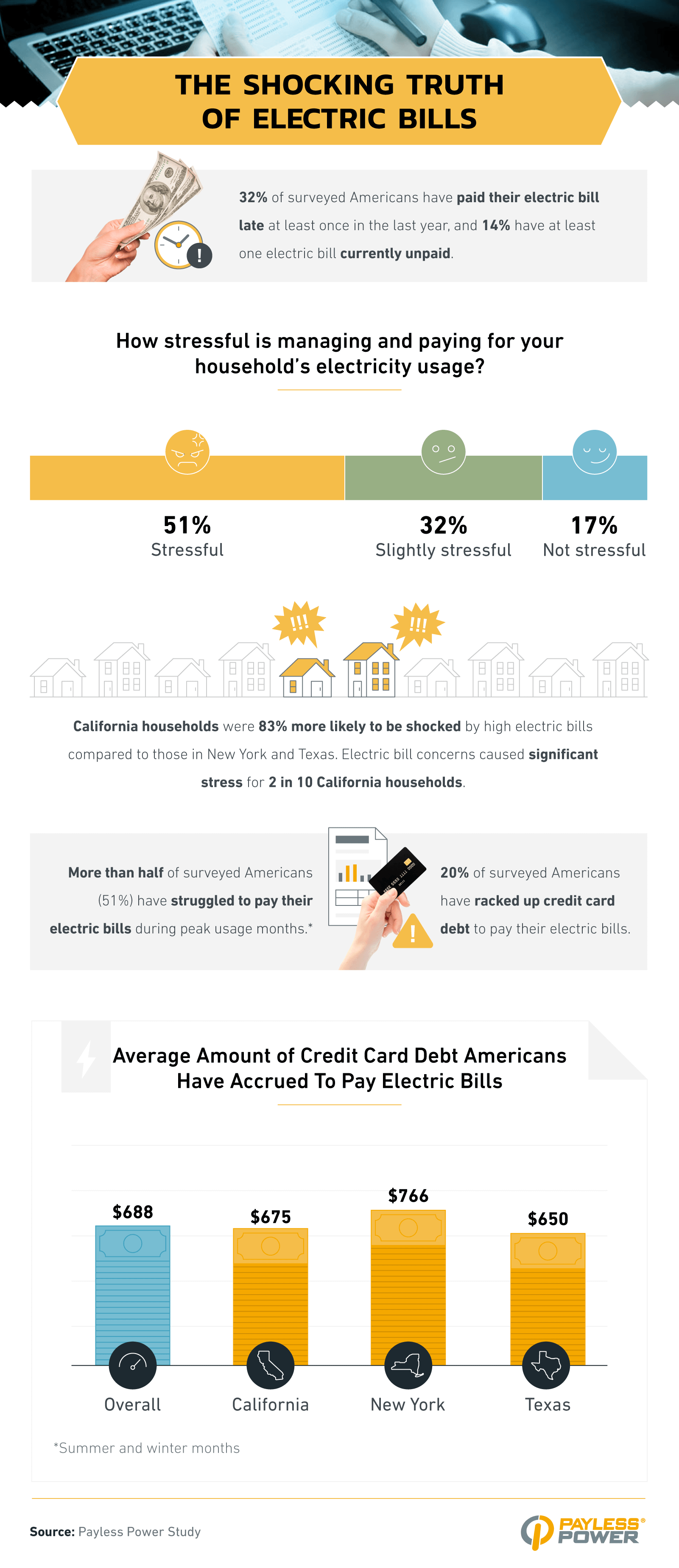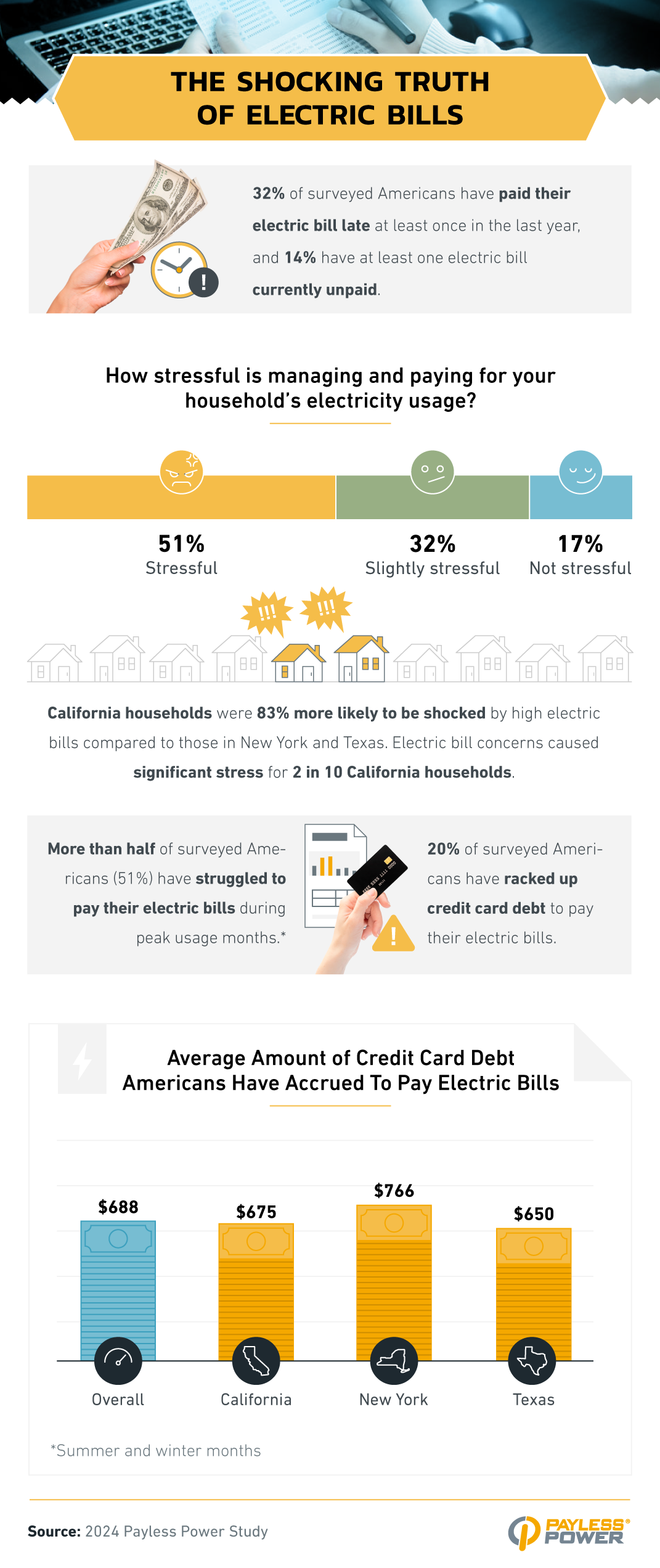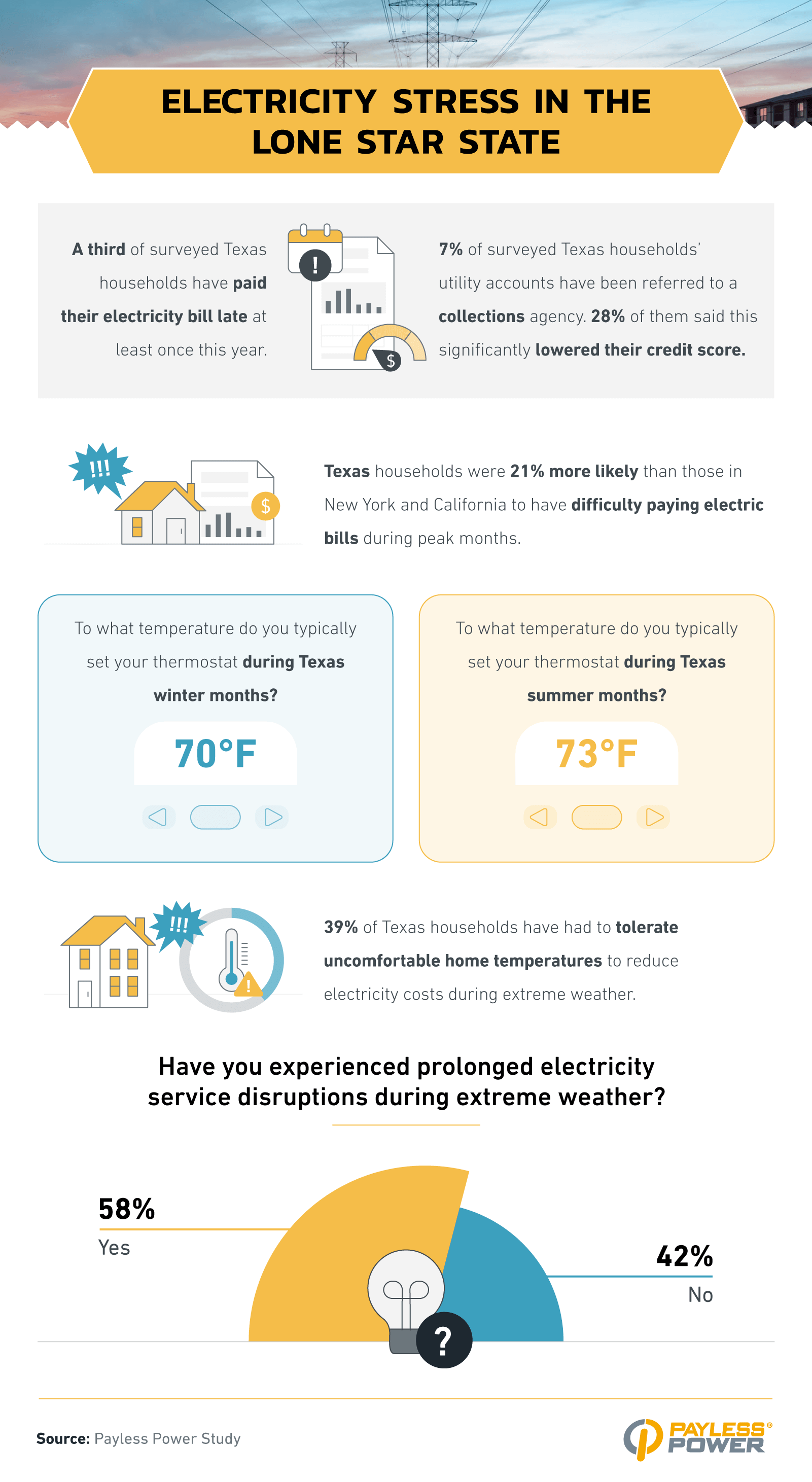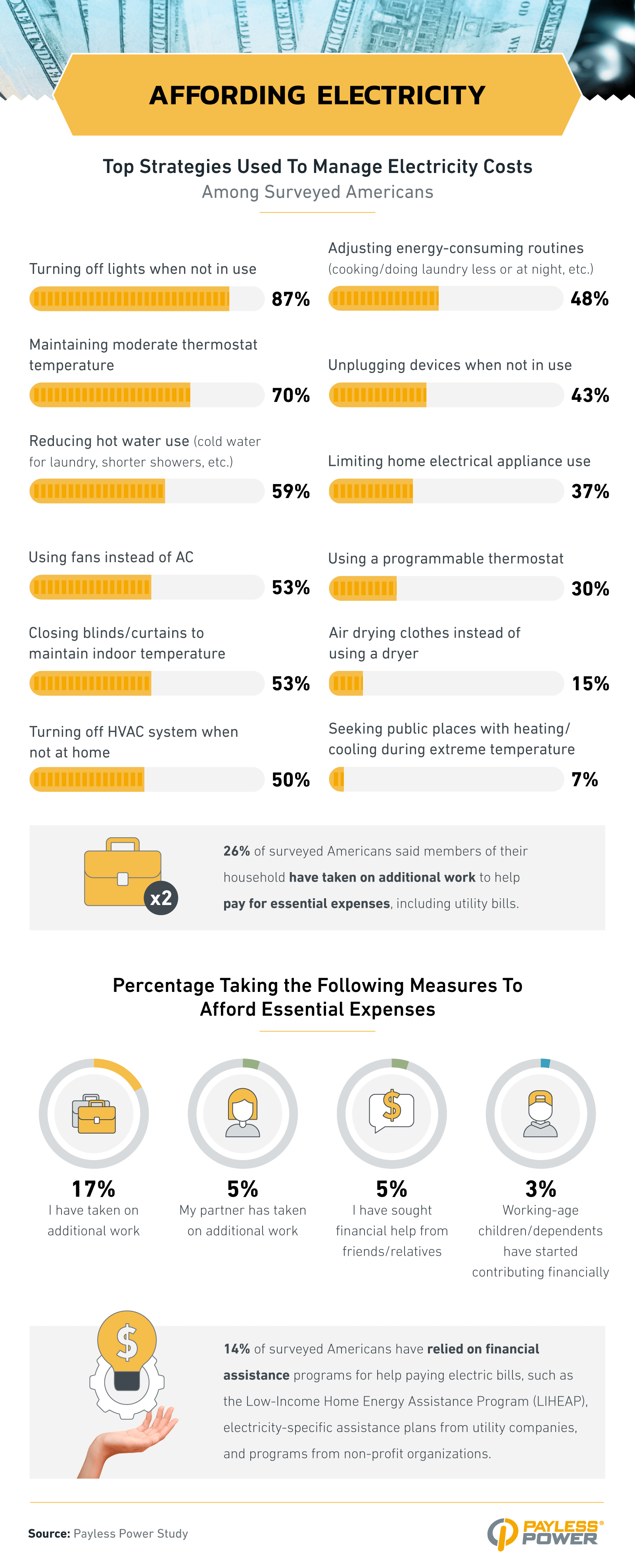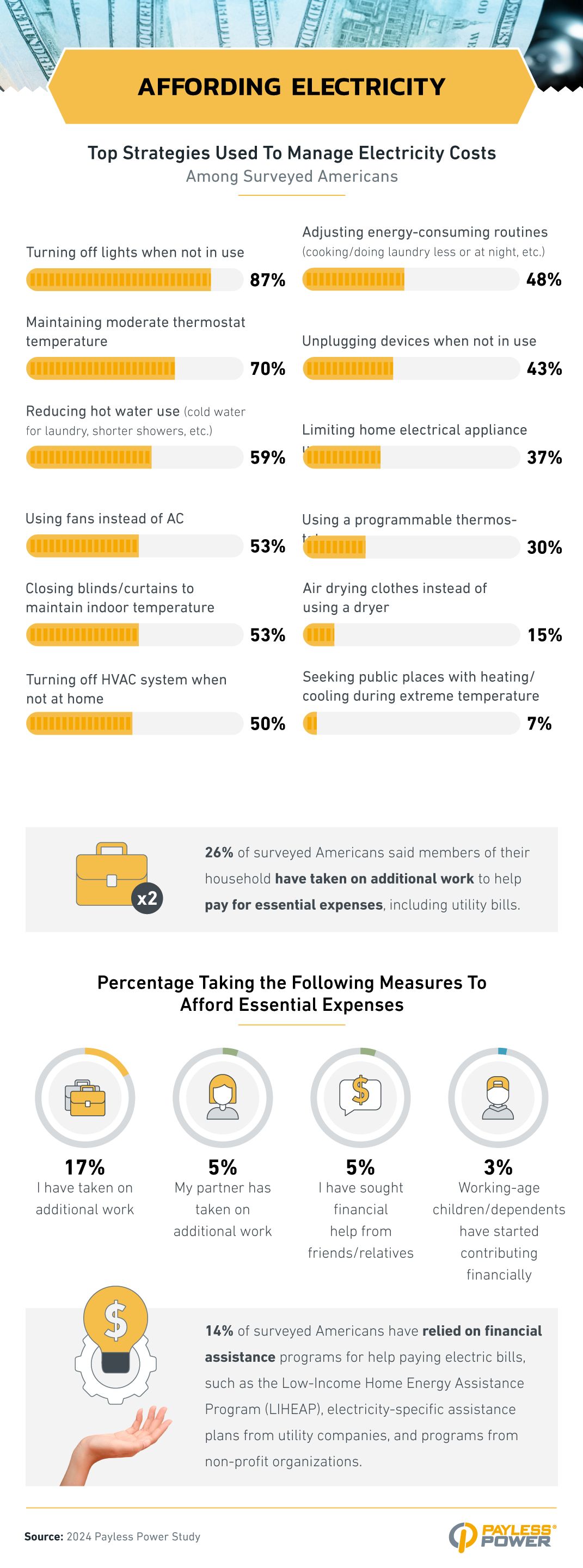The High Cost of Power: Texas to New York Comparison
Managing utility expenses, particularly electricity bills, has become a significant concern for many American households. With the rising cost of living, families across the U.S., from Texas to New York, are grappling with the high cost of staying powered. Our latest research sheds light on these struggles based on a comprehensive survey about the stress of utility debt and how Americans manage their electricity costs — especially those facing extreme weather.
Key Takeaways
- 32% of surveyed Americans have paid their electric bill late at least once in the last year.
- 20% of surveyed Americans have racked up credit card debt to pay their electric bills; on average, they’ve acquired $688 of credit card debt.
- 26% of surveyed Americans say members of their household have taken on additional work to help pay for essential expenses, including utility bills.
- 39% of Texan households have had to tolerate uncomfortable home temperatures to reduce electricity costs during extreme weather.
Electric Bill Struggles
Late payments and the financial stress associated with managing electricity bills have been common lately in different parts of the U.S. This section explores the prevalence of these challenges, offering insight into how they impact American households.
A substantial 32% of Americans surveyed admitted to being late on their electricity bill payment at least once this year, underscoring the widespread nature of high electric bills. Furthermore, 14% of respondents are currently behind on at least one electric bill, revealing a troubling pattern of financial strain. The burden of electricity costs does not end with late payments; 20% of those surveyed had resorted to accruing credit card debt to keep their lights on, with the average debt amounting to $688.
The emotional toll of managing electricity expenses is equally concerning. Over half (51%) described the process as stressful, while an additional 32% found it slightly stressful. These statistics paint a stark picture of the financial and psychological pressure electricity costs can have on American households, with a significant portion of the population struggling to pay their bills on time.
Weather and Electricity Costs
Extreme weather can make it hard for many Texans to manage their electricity costs. We compared these challenges to those of residents in other states, including stress levels, adaptive behaviors, and how weather impacts energy reliability.
Affording electricity bills during peak months was notably harder in Texas than in the other states we studied — Texas households were 21% more likely than New York and California households to find paying their electric bills difficult during summer and winter months. The extreme weather Texans have faced lately has exacerbated this issue, leading 39% of these households to endure uncomfortable temperatures to reduce electric costs. Case in point: 58% have faced prolonged service disruptions during these extreme weather events, knocking out heat in the cold winter and air conditioning in the hot summer.
Many Texans have taken proactive measures to cope. One example is upgrading home insulation to reduce energy consumption and electricity costs, which 19% of Texas households have done. Another 14% have invested in backup power sources, ensuring they’ll have access to electricity when they need it most.
Managing Expenses
Texas households are uniquely challenged when it comes to managing electricity costs. This section highlights their strategies for handling these challenges and explores other measures Americans nationwide are taking to reduce costs.
The most common approach Texans have adopted to control energy consumption and manage electricity bills is maintaining a moderate thermostat temperature (70%). Closely following, 69% have reduced their overall electricity usage, 53% have covered windows to maintain indoor temperatures, 47% have switched to energy-efficient light bulbs, and 37% have limited the use of electrical appliances.
In Texas and elsewhere in the U.S., residents have taken to some new financial strategies as well. Over a quarter (26%) reported that someone in their household has taken on additional work to cover essential expenses, including utility bills. Others (14%) said they rely on financial assistance programs for help paying their electric bills. Options included:
- Support from the Low-Income Home Energy Assistance Program (LIHEAP)
- Electricity-specific assistance plans from utility companies
- Various programs offered by non-profit organizations
These findings highlight the significant lengths households are going to ensure their energy needs are met while managing financial pressures.
Brighter Futures With Accessible Energy
Paying electric bills is tough for families all over the U.S., from Texas to New York, especially during extreme weather. Texans have had it especially hard, but they’ve found smart ways to save money on electricity to keep their families comfortable. With many families needing extra income or financial assistance programs to pay for their electricity, it’s been especially important lately to keep energy costs low and make sure electricity is affordable for everyone.
Methodology
We surveyed 1,000 Americans to shed light on the financial struggles of residents in key states, including California, New York, and Texas. Among them, 34% were residents of California, 29% were residents of New York, and 37% were residents of Texas. Personal annual income levels of respondents were as follows:
- Less than $25,000 (26%)
- $25,000 to $34,999 (13%)
- $35,000 to $49,999 (19%)
- $50,000 to $74,999 (27%)
- $75,000 to $99,999 (12%)
- $100,000 and above (3%)
Household income levels of respondents were as follows:
- Less than $25,000 (12%)
- $25,000 to $34,999 (9%)
- $35,000 to $49,999 (12%)
- $50,000 to $74,999 (26%)
- $75,000 to $99,999 (17%)
- $100,000 and above (25%)
As for homeownership status, 52% were renters, 31% were homeowners with a mortgage, 13% were homeowners without a mortgage, and 3% said they were something else. Some percentages may not total 100 exactly due to rounding.
About Payless Power
Your credit shouldn’t impact your access to energy. That’s why Payless Power provides flexible, prepaid, and traditional Texas energy plans that are competitively priced with no credit check required.
Fair Use Statement
Are you concerned about the impact of electricity costs on households? Feel free to share this article with anyone you’d like. We just ask that you do so for noncommercial purposes only and provide a link back to this page to give the authors their due credit.
What our customers are saying
See why our power customers say we're the best electricity provider in Texas!
I was worried about getting electricity for my home through a prepaid company. I was calling around to see different rates then going through all the hassle of credit checks while dropping points each…
I have been with this company for several years and have been very happy since. Even when I moved, they made my usually stressful situation very easy and carefree. I recommend them to everyone that I…
I have enjoyed the service for 2 years now. In the beginning this service was planned to be temporary but with the service being so effective for me i decided to keep it for the long haul. I’m a happy customer.


